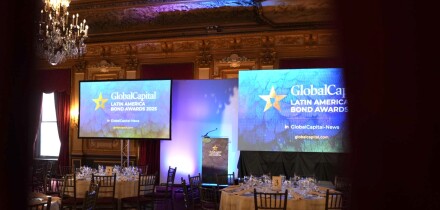Convertible bond holders are generally short dividend risk. That is, higher-than-expected dividends on the underlying shares may reduce the convertible bond's value. This is because the cost of delta-hedging a convertible rises as dividends increase due to stock borrowers physically paying out the higher dividends on their short stock position (ie, the equity forward falls). The dividend sensitivity, denoted by the greek letter µ (mu), is relatively more pronounced for convertibles with:
* a high delta;
* large intrinsic value;
* long time to maturity (or expected life, if redeemable before maturity); and
* little or no dividend protection.
In this two-part Learning Curve, we describe how dividends impact some of Europe's most liquid convertible bonds, how dividend protection features in certain convertibles may compensate holders for this risk (to some extent), how to estimate the resulting dividend sensitivity (µ) of convertibles and strategies for hedging the dividend risk in convertibles, including relatively new products such as dividend swaps.
Dividend Impact On European Convertibles
It is sometimes claimed that derivatives professionals have short memories. Mentioning Daimler-Chrysler to seasoned convertibles practitioners, however, will likely elicit a response. In March 1998, the auto company declared a DM20 special dividend per share (then 11.6% of the share price), which negatively impacted the valuation of Daimler's then DM1.2bn (EUR614 million) outstanding of in-the-money 4.125% convertible bonds due 2003. Although Daimler compensated bondholders for part of the foregone dividend, bond investors were still left nursing a hit of more than 6%.
This example was dramatic, but not unique. Convertible bond investors could risk significant dividend-related losses in the future, especially as we are seemingly returning to an era of more shareholder-focused corporate policies. Fortunately, many new convertible bond offering circulars provide full protection for extraordinary dividends and other forms of capital distributions. Some also protect holders against increases in ordinary dividends, either fully or partially. That is, for the excess dividends either above a specified dividend yield threshold or above a specified dividend growth rate threshold. Dividend protection may be implemented via a conversion/exchange ratio increase, or via a cash payment to bondholders. Figure 1 below outlines the dividend sensitivity, mu (µ), together with any protection features, for some of the most liquid European convertibles. At this point, we emphasize there is no substitute for analysing the convertible's offering circular to see exactly what (if any) protection features there are.
| Figure 1: European Convertible Bond Dividend Exposures & Protection Features | ||||
| Issue | Amt out. (€ mn) | m (Ä mn)* | Delta | Dividend protection** |
| KfW - Deutsche | Full dividend protection, via ratio | |||
| Telekom 0.75% | 5000 | 58 | 56% | adjustment or cash payment on |
| 2008 | conversion, at issuer’s option | |||
| Fortis ‘FRESH’ | 1250 | 46.5 | 41% | Excess above 5% yield. |
| Siemens 1.375% | 2500 | 41.3 | 71% | Excess above prior FY divs, provided |
| 2010 | current FY divs are greater than lesser of | |||
| three times the average of the prior five | ||||
| years’ dividends, excluding those declared | ||||
| as “extraordinary”, and 5% yield. | ||||
| Deutsche Telekom | 2288.5 | 30.4 | 83% | Cash payment of excess above lesser |
| 6.5% 2006 MCS | of average of prior two years’ divs and | |||
| 5% yield. | ||||
| Pemex - Repsol | 1036 | 29.1 | 67% | Excess of FY gross divs above $0.49 per |
| 4.5% 2011 | share (equivalent to €0.40 at issue). | |||
| Glencore - Xstrata | 603.3 | 17.3 | 73% | Excess above greater of 120% of prior |
| 4.125% 2010 | FY divs and $0.20 per share. | |||
| Capitalia - Generali | 1056.6 | 14.5 | 51% | Excess above 25% growth from initial |
| 1.625% 2009 | €0.33 per share. | |||
| France Telecom | 1150 | 13.8 | 54% | Excess above 6% yield. |
| 1.6% 2009 | ||||
| Adidas-Salomon | 400 | 13 | 72% | Excess above 3.5% yield. |
| 2.5% 2018 | ||||
| Xstrata 3.95% | 452.5 | 12.5 | 87% | Excess above greater of 120% of prior |
| 2010 | FY divs and $0.20 per share. | |||
| Arcelor 3% 2017 | 750 | 12 | 49% | Excess above average of the prior five |
| years’ yields, provided FY yield > 8.5%. | ||||
| Alcatel 4.75% 2011 | 1022.4 | 11.5 | 48% | Excess above 4% yield, provided FY |
| yield > 5%. | ||||
| Unicredito - Generali | 1148 | 11.4 | 40% | Excess above 25% growth from initial |
| 2.5% 2008 | €0.28 per share. | |||
| Swiss Re 6.125% | 671.9 | 11.2 | 83% | Cash payment (in euros) of excess above |
| 2007 MCS | 15% growth from initial SFr1.27 per | |||
| share. | ||||
| Numico 3% 2010 | 345 | 10.9 | 78% | Full protection. |
| Vivendi - Sogecable | 605 | 10.2 | 67% | Excess above 2% yield, provided FY |
| 1.75% 2008 | yield > 3%. | |||
| Man Group 3.75% | 581 | 10.2 | 69% | Full protection if declared “special”, |
| 2009 | “extraordinary”, etc; otherwise, excess | |||
| above greater of (a) prior FY divs and (b) | ||||
| sum of 50% of FY EPS and excess of | ||||
| prior three years divs above 50% of | ||||
| prior three years’ EPS. | ||||
| Source: Bloomberg, Barclays Capital. Note, m is calculated as the change in theoretical value for a one percentage point rise in the dividend yield assumption, multiplied by the amount outstanding. | ||||
| *Here, m excludes the impact of any dividend protection features. | ||||
| **Dividend protection is implemented via conversion/exchange ratio adjustment unless otherwise indicated. |
Quantifying Dividend Risk Of Convertibles
An illustrative example is France Telecom's five-year convertible bond issued September. The prospectus provides protection for bondholders for dividends above a 6% yield threshold via conversion ratio increases. Assuming a projected 3% dividend yield, our model indicates a one basis point increase/decrease from our base-case dividend yield assumption would result in a loss/gain of approximately 1.15 basis points. Hence, µ = 1.15bps for this bond.
Mu may be hedged in a variety of ways, with instruments such as stock forwards, options, or dividend swaps. We return to dividend swaps below, but the idea is investors could trade a strip of annual dividend swaps for the years 2005-9 with an equal and opposite µ risk profile to that of the convertible.
Impact Of Dividend Protection Features
As with most equity options, the hedge ratio (or dividend swap notional) must be adjusted as the convertible's equity delta changes (due to changes in the stock price, volatility, credit spread, etc) and as time elapses. Moreover, dividend protection features should be reflected in the base-case modelling assumption and therefore in the hedge ratio, as in Figure 2 (below) for France Telecom's convertible.
From a base-case 3% dividend yield level, the valuation of the France Telecom convertible should rise if dividend yields fall and vice-versa: although the valuation downside is limited to the 6% dividend yield threshold. As such, holders are effectively short dividends and, owing to the protection feature, long a call on dividends (far out of the money, in this case). If the convertible valuation model does not explicitly incorporate dividend protection features with thresholds (as many do not), then the base-case dividend assumption should be reduced to reflect this asymmetric dividend exposure profile.

As with many other similar dividend protection features, France Telecom's convertible bond embedded dividend option is actually a series of five one-year call options on the dividend yield, this is because the threshold condition is assessed annually. Valuation of these dividend options is an imprecise science and depends strongly on the assumptions about future dividend probability distributions, which in turn is crucially a function of the company's stated/expected dividend policy. Certainly, we expect dividends five years out to be more uncertain than dividends one year out and therefore expect the fifth dividend option to be more valuable than the first.
Suppose, for the sake of illustration, this option is worth an average 0.1% per annum in dividend yield terms and the valuation model excludes dividend optionality: then the base-case dividend yield assumption should be revised down from 3% to 2.9%. For France Telecom's convertible, a 10bps dividend yield reduction would boost its valuation by 12bps. This impact can become more significant for other convertible bonds or as market variables change, for example if dividend yields and/or equity prices rise.
This week's Learning Curve was written by Luke Olsen, head of convertible bond research at Barclays Capitalin London.





